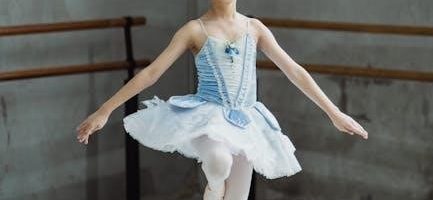Properly fitting pointe shoes are essential for performance and comfort. Sizing varies by brand, even for the same street shoe size. Understanding your foot type and brand differences is key to finding the perfect fit. A professional fitting ensures optimal support and prevents injuries. This guide will help you navigate the complexities of pointe shoe sizing.
Understanding the Importance of Proper Fit
A proper fit in pointe shoes is crucial for both performance and injury prevention. Ill-fitting shoes can lead to discomfort, blisters, and even long-term damage to the feet. Properly fitted shoes provide the necessary support and alignment, allowing dancers to execute techniques effectively. A snug yet comfortable fit ensures optimal performance and prevents common issues like bunions or calluses. Investing time in finding the right fit is essential for a dancer’s career longevity and overall well-being.
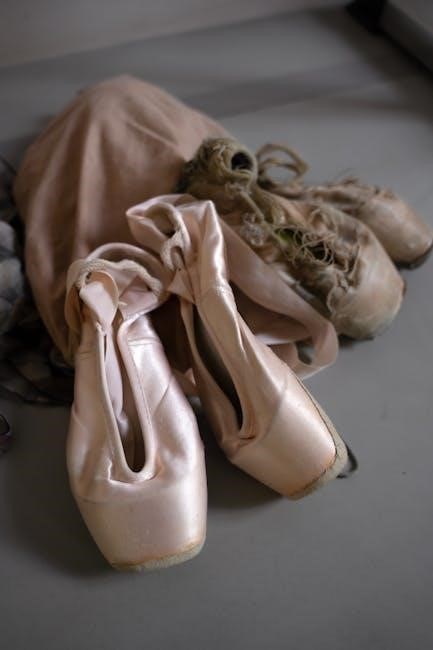
Foot Type and Shape
Foot type significantly impacts pointe shoe fit. Dancers with different toe lengths, arch types, and foot shapes require tailored shoes. Proper alignment and support are crucial.
How Foot Anatomy Affects Pointe Shoe Fit
Your foot’s anatomy, including toe length, arch height, and foot shape, plays a crucial role in determining the right pointe shoe fit. Dancers with longer toes may need a longer vamp to accommodate their foot structure, while those with shorter toes might find a shorter vamp more comfortable. The height of the arch can affect how the shank supports the foot, with higher arches often requiring stronger shanks for proper alignment and stability. Understanding these elements ensures a secure and supportive fit, preventing discomfort or injury during performance.
Determining Your Foot Type
Your foot type significantly influences pointe shoe fit. Common foot types include Egyptian (toes decrease in length), Greek (second toe longest), and square (toes similar in length). Identifying your foot type helps determine the best box shape and vamp length. For example, dancers with longer toes may need a longer vamp, while those with shorter toes prefer a shorter vamp. Understanding your foot type ensures proper alignment, comfort, and support, crucial for optimal performance and injury prevention. A professional fitter can help assess your foot type and recommend the ideal shoe features.
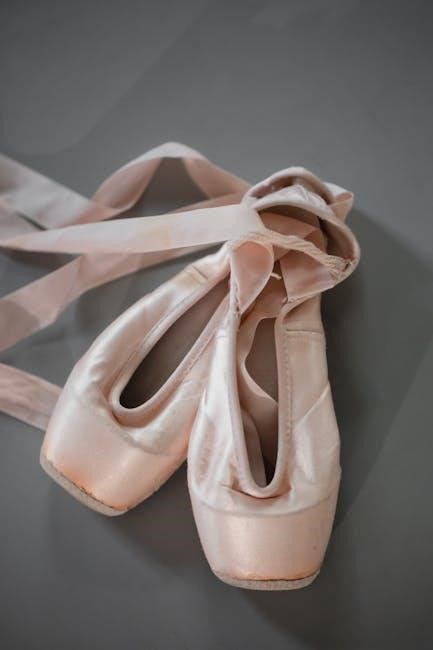
Professional Fitting
Professional fitting ensures optimal support and performance. Expert fitters assess foot type, recommending styles that align with your anatomy. This personalized approach enhances comfort and technique.
Why Professional Fitting is Crucial
Professional fitting is essential for dancers to ensure proper support, prevent injuries, and optimize performance. Expert fitters analyze foot shape, toe alignment, and arch height to recommend the best fit. They consider factors like brand differences, box type, and shank strength, tailoring the shoe to individual needs. A well-fitted pointe shoe enhances comfort, technique, and overall dancing experience, making professional fitting a crucial step in a dancer’s journey.
Proper fit prevents common issues like blisters, bunions, and poor alignment.
What to Expect During a Fitting
During a pointe shoe fitting, expect a thorough assessment of your feet, including shape, size, and alignment. The fitter will measure your foot length and width, and discuss your dance experience. They will bring several shoe options, helping you try them on and check the fit. You’ll stand, walk, and possibly go en pointe to ensure comfort and support. The fitter will also offer advice on care and maintenance. Be prepared to spend about 30 minutes to an hour ensuring the perfect fit for optimal performance and comfort.
Determining the Correct Size
Correct pointe shoe size involves matching foot length, width, and shape. Brands vary, so try several to find the best fit. Professional guidance ensures accuracy and comfort.
Using Street Shoe Size as a Guide
While street shoe size provides a starting point, it’s not always reliable for pointe shoes. Differences in brand, foot shape, and fit requirements can lead to variations. Many dancers find their pointe shoe size is smaller than their street shoe size due to the need for a snug fit. However, relying solely on street shoe size can be misleading, as foot anatomy and brand-specific sizing play significant roles. A professional fitter can help determine the best size based on these factors.
How Brand Differences Impact Sizing
Each pointe shoe brand has unique sizing standards, making direct comparisons challenging. For instance, a size 7 in one brand may not align with another, as differences in box shape, vamp length, and shank strength vary. Some brands cater to specific foot shapes, offering narrower or wider boxes. It’s crucial to try on multiple brands to find the best fit, as even a slight variation can affect comfort and performance. Professional fitters often recommend trying several options to determine the most suitable brand and size for individual needs.
Understanding Length vs. Width Measurements
Accurate length and width measurements are vital for a proper pointe shoe fit. Length ensures the shoe supports the entire foot, while width must accommodate the toe box comfortably. A shoe that’s too short may restrict movement, while excessive length can cause blisters. Similarly, a narrow width can compress toes, leading to discomfort, whereas too wide a fit may reduce support. Measuring both dimensions helps determine the ideal size, ensuring balance between snugness and freedom for optimal performance and comfort.
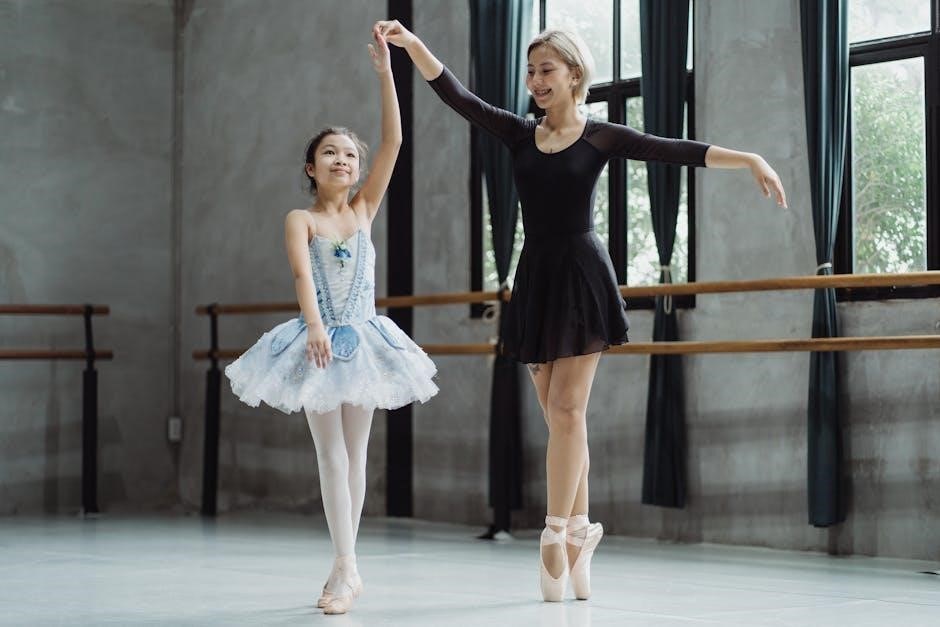
Box Type and Fit
Proper box fit ensures toes lie flat without compression or excess space. A well-fitted box supports proper alignment and movement, crucial for technique and comfort in pointe work.
How to Determine Your Box Type
To determine your box type, start by assessing your foot shape and toe alignment. Narrow boxes suit slender feet, while wide boxes accommodate broader toes. Medium boxes are ideal for average foot shapes. A professional fitter will evaluate your foot’s natural alignment and how your toes sit in the box. They may also consider your dancing experience and preference for support. Proper box fit ensures toes lie flat without compression or excessive space, crucial for optimal performance and comfort in pointe shoes.
Common Mistakes in Box Fit
One common mistake is choosing a box too tight, causing toe compression and discomfort. Conversely, a box too wide can lead to poor support and difficulty in maintaining proper technique. Dancers often overlook the importance of toe alignment; ensuring toes lie flat is crucial. Another error is prioritizing aesthetic over comfort, which can hinder performance. A professional fitter can help avoid these pitfalls, ensuring the box fits snugly without restricting movement or causing pain. Proper box fit is essential for both performance quality and dancer health.
Vamp Length and Fit
Vamp length is critical for proper support and movement. A well-fitted vamp ensures toes align correctly, preventing discomfort or restricted articulation during performance. Snug yet comfortable is key.
Importance of Vamp Length
The vamp length is crucial for proper support and movement in pointe shoes. It must fit snugly to prevent excessive toe movement while allowing enough room for proper articulation. A vamp that is too short can restrict toe alignment, leading to discomfort or injury. Conversely, a vamp that is too long may cause blisters or reduce control. Proper vamp length ensures optimal performance, enabling dancers to execute movements smoothly and maintain balance. It is essential for both comfort and technical accuracy, making it a vital factor in pointe shoe sizing.
How to Measure for Vamp Length
To measure for vamp length, stand in a turned-out position and gently extend your foot. The vamp should align with the longest toe, ensuring proper support and alignment. A fitter may use a soft measuring tape or a pre-sized gauge to determine the ideal length. The vamp should fit snugly, allowing toes to lie flat without curling or overlapping. Proper measurement ensures the shoe supports the foot during demi-plié and pointe work, preventing discomfort or injury. Accurate vamp length is essential for optimal performance and comfort in pointe shoes.
Shank Strength
Shank strength refers to the stiffness of the pointe shoe’s sole, supporting the arch during movements. Choosing the right strength ensures proper support and alignment for optimal performance.
Understanding Shank Options
Pointe shoe shanks vary in strength, offering different levels of support. Soft shanks provide flexibility, while hard shanks offer maximum stability. Dancers choose based on experience, foot strength, and technique. Proper shank strength ensures optimal arch support and alignment, preventing injuries. Understanding shank options is crucial for matching individual needs, ensuring both comfort and performance during dances.
Choosing the Right Shank Strength
Selecting the correct shank strength balances support and flexibility. Beginners often choose softer shanks for ease, while advanced dancers prefer harder shanks for stability. Consider foot strength, technique, and personal comfort; A professional fitter can guide you to the ideal shank, ensuring proper alignment and performance. The right shank strength prevents injuries and enhances dancing efficiency, making it a vital part of your pointe shoe fit.
Next Steps After Fitting
After your fitting, break in your pointe shoes gradually. Start with short practice sessions and increase duration as they mold to your feet. Proper care ensures longevity and performance.
Breaking In Your Pointe Shoes
Breaking in pointe shoes requires patience and care. Start by wearing them for short practice sessions, gradually increasing duration as they mold to your feet. Avoid forcing the box or shank, as this can weaken the structure. Gently bend the shank to improve flexibility without breaking it. Use a hairdryer or ice pack to soften or firm the material if needed. Rotate between pairs to allow them to rest and retain their shape. Proper breaking-in ensures comfort, support, and optimal performance during dances.
Care and Maintenance Tips
Proper care extends the life of pointe shoes. After use, remove any dirt or sweat with a damp cloth. Allow shoes to air dry completely, avoiding direct sunlight; Stuffing the toes with paper helps maintain shape. Store them in a cool, dry place away from heat. Avoid sharing shoes to prevent damage or fit issues. Regular inspections for wear and tear help determine when replacements are needed. By following these tips, you ensure your pointe shoes remain supportive and comfortable for every performance.
Breaking In Pointe Shoes
Properly breaking in pointe shoes ensures comfort and prevents damage. Gently flex the box and vamp, and consider using a shoe stretcher for tough areas. Avoid harsh methods like extreme bending or excessive force, as they can weaken the structure. Regular wear and gentle stretching are key to achieving the perfect fit without compromising support.
Methods for Breaking In
Effective methods for breaking in pointe shoes include gently flexing the box and vamp to mold them to your feet. Start by wearing them for short periods and gradually increase duration. Use a shoe stretcher for tough areas but avoid extreme bending or force, which can weaken the structure. Softening the glue in the shank with a hairdryer or warm water can enhance pliability. Rotate between pairs to allow shoes to recover shape. Avoid harsh methods like crumpling or excessive stretching, as they may compromise support and longevity.
Common Mistakes to Avoid
One common mistake is over-tightening the ribbons, which can restrict circulation and cause discomfort. Another error is choosing a shoe too small, leading to cramped toes and potential injury. Dancers often overlook the importance of proper box shape and vamp length, which are crucial for support and alignment. Additionally, neglecting professional fittings can result in ill-fitting shoes that hinder performance. Avoiding these mistakes ensures a comfortable and secure fit, allowing dancers to perform at their best without compromising foot health or technique.
The Lifespan of Pointe Shoes
Pointe shoes have a limited lifespan due to natural materials breaking down. Usage frequency and quality determine durability. Replace when support decreases to ensure proper foot protection and performance.
Understanding the Lifespan
The lifespan of pointe shoes depends on usage frequency, quality, and dancer experience. Professional dancers may need new shoes every 3-4 weeks, while recreational dancers can extend use up to 6 months. Materials like glue and leather degrade naturally, affecting support. Overuse or poor fit accelerates wear. Proper care, like avoiding extreme temperatures, can extend longevity. Monitoring for visible signs of wear, such as softened shanks or torn boxes, is crucial for maintaining performance and foot health. Regular inspections ensure optimal support and prevent injuries.
When to Replace Your Shoes
Replace pointe shoes when they show significant wear or lose structural integrity. Look for softening of the shank, separation of the glue layers, or a torn box. If the shoes no longer support the foot properly or cause discomfort, it’s time for a new pair. Dancers should also consider replacing their shoes if they notice a decline in performance or increased risk of injury. Regular inspections and professional advice can help determine the optimal time for replacement to ensure continued support and protection for the feet during performances.
Factors Influencing Size
Foot shape, brand differences, and age affect pointe shoe sizing. Each brand offers varying fits, and feet change with growth and experience, necessitating regular assessments for proper fit.
Age and Experience Level
A dancer’s age and experience significantly impact pointe shoe sizing. Younger dancers with developing feet may need more frequent fittings as their feet grow. Experienced dancers often prefer a snug, supportive fit to maintain proper technique. Proper sizing ensures optimal performance and injury prevention at every level.
Brand and Model Differences
Different brands and models cater to various foot types and preferences. Some brands offer wider boxes for square toes, while others focus on narrow, tapered designs. Shank strength varies from soft to hard, supporting dancers with unique needs. Understanding these variations helps in selecting the most suitable shoe for optimal support and performance.

Common Fitting Mistakes
Ill-fitting pointe shoes can cause discomfort and injury. Common mistakes include choosing shoes too small, improper box fit, and incorrect vamp length, all of which hinder performance.
Mistakes to Avoid
Common errors include choosing shoes too small, causing toe compression and discomfort. Improper box fit can lead to inadequate support and poor alignment. Incorrect vamp length may result in excessive foot movement, affecting technique. Ignoring shank strength preferences can compromise stability. Overlooking professional fitting guidance increases the risk of ill-fitting shoes. Prioritizing aesthetics over comfort can lead to injuries. Ensuring proper fit is crucial for optimal performance and dancer well-being.
Troubleshooting Fit Issues
If your pointe shoes feel too tight, consider a larger size or a different brand. If they’re too loose, opt for a smaller size or a narrower fit. For gapping at the heel, ensure the ribbons are securely tied. If the box feels too wide, try a narrower box type. For vamp length issues, adjust by ensuring proper fit during standing and relevé. Addressing these problems promptly ensures comfort and prevents long-term foot issues, enhancing overall performance and technique.
Professional Fitting Process
A professional fitter assesses foot shape, arch height, and toe alignment to recommend the best fit. They ensure proper support and comfort, crucial for optimal performance and injury prevention.
Preparing for Your Fitting
Before your fitting, ensure your toenails are trimmed and wear snug, form-fitting socks. Bring any previous pointe shoes for comparison. Be prepared to discuss your dance experience, preferences, and any foot concerns. The fitter will assess your foot shape, arch height, and toe alignment to determine the best fit. Arrive with clean feet and avoid lotion to ensure accurate sizing. This preparation helps the fitter recommend the most suitable shoes for your needs, ensuring comfort and support during performances.
What to Expect
During your fitting, an expert fitter will assess your foot shape, arch height, and toe alignment to determine the best fit. They will guide you through trying on several styles and sizes, ensuring proper support and alignment. Expect a thorough discussion about box type, vamp length, and shank strength to match your needs. The fitter will check for proper fit by ensuring your toes are aligned, the box supports your foot, and the vamp length is appropriate. This personalized process ensures you leave with shoes that provide optimal comfort and support for your performances.
Properly fitted pointe shoes are vital for performance and comfort. With expert guidance, you can find the perfect fit, ensuring support and confidence in every step forward.
Final Tips for the Best Fit
For the best pointe shoe fit, prioritize professional guidance and consider your foot anatomy. Ensure snugness without discomfort, and choose shanks that support your technique. Regularly inspect and maintain your shoes to extend their lifespan. Remember, proper fit enhances performance and prevents injuries, so take the time to find your ideal pair and care for them diligently to ensure optimal support and longevity in your dance career.
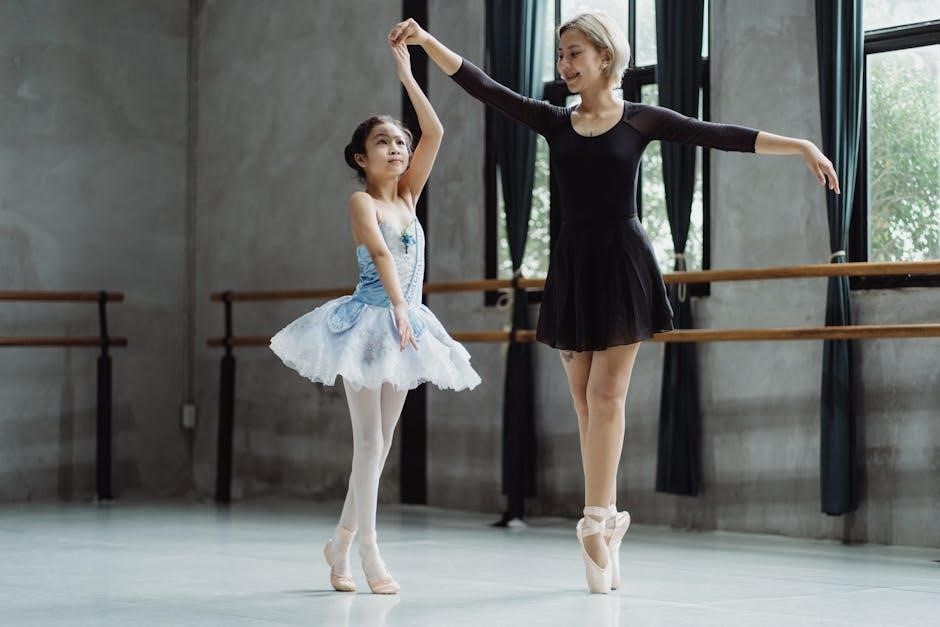
Additional Resources
Explore reputable dance websites, manufacturer guides, and expert blogs for detailed pointe shoe sizing charts and fitting tips. Utilize online forums and professional fitters for personalized advice.
Where to Find More Information
Reputable dance websites, manufacturer guides, and expert blogs offer detailed sizing charts and fitting tips. Online forums and social media groups provide dancer testimonials and advice. Professional fitters and dance schools often share resources. Utilize these sources to enhance your understanding of pointe shoe sizing and ensure a proper fit tailored to your needs.

